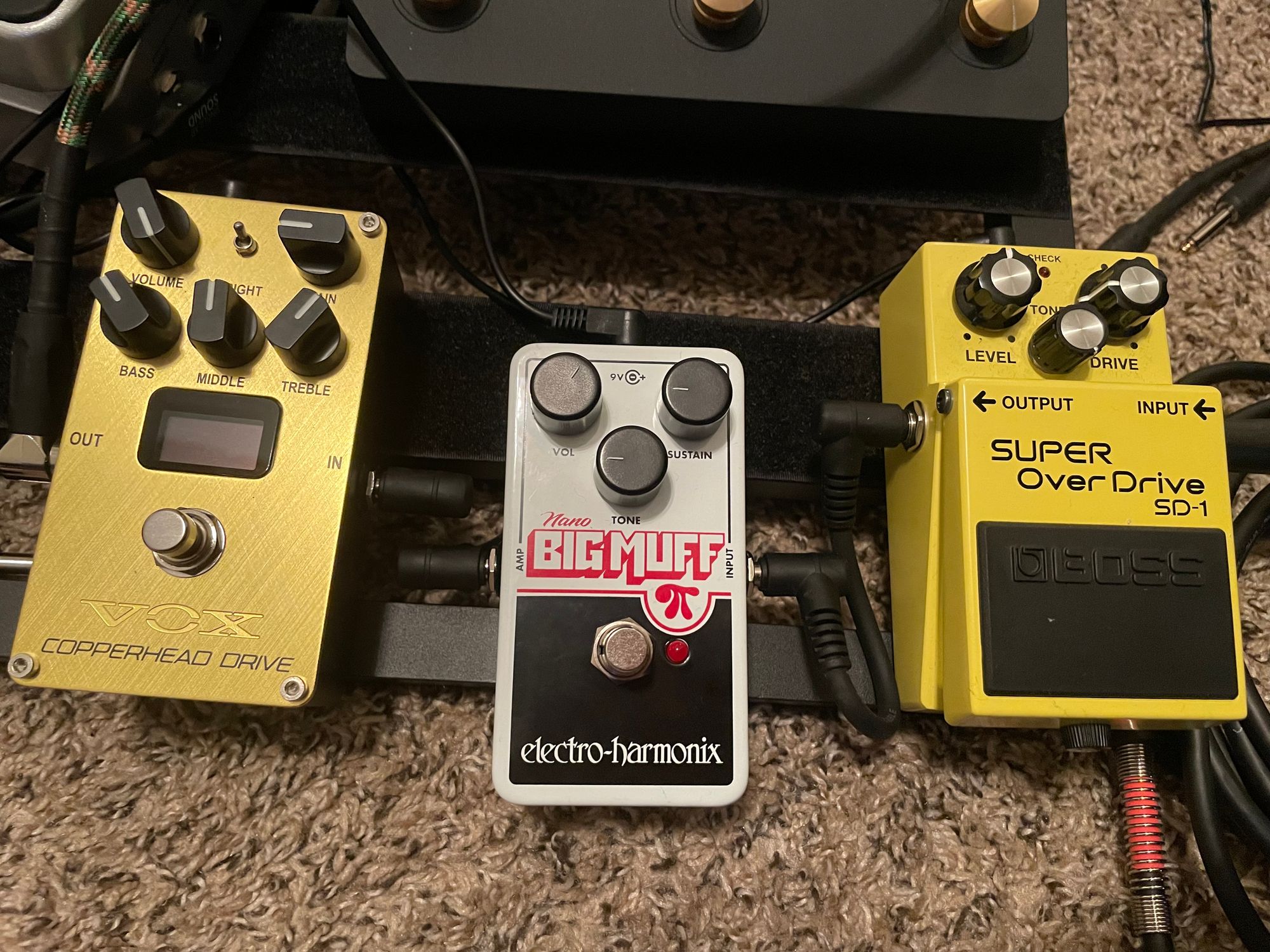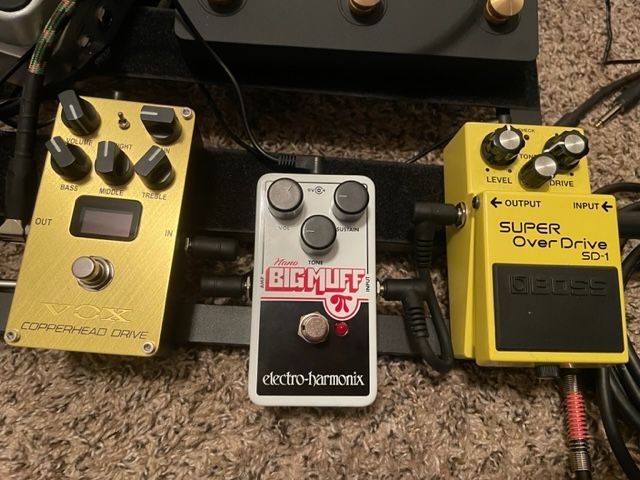VOX Copperhead Drive: The Underrated Amp Sim Pedal

Join me as we take a look at the VOX Valvenergy Copperhead Drive, an overlooked gem that delivers classic Marshall amp tones and feel and could just be your new secret weapon. We'll dive into it's features and performance comparing it to other amp sims.
The Power of Nutube Technology: A New Era
We can't properly review any of the VOX Valvenergy pedals without first understanding Nutube. If you haven't heard of this technology before you're not alone. It seems that a lot of guitarists have slept on this technological development, which is a real shame as it has the potential to usher in a new era for guitar pedals and amplifiers.
Nutube was created as a collaboration between KORG and Noritake Itron Corp as a new type of vacuum tube. Don't be fooled, it's not a gimmicky simulation of a tube, but a vacuum fluorescent display used to process audio . They're basically micro sized tubes with minimal power draw but none of the drawbacks in terms of tone or feel.
After playing with the VOX Copperhead Drive for a few weeks now, I truly feel like it has the same rich, warm and dynamic tones that traditional vacuum tubes are known for. Many guitarists who've tried Nutubes online echo my sentiment, and while not popular in the U.S. it does appear this tech (and the Valvenergy pedals) is popular in Japan.

Compact Pedal Format, Big Sound: How the Copperhead Drive Reproduces the Marshall Amp Experience
I'll cut right to the point: the VOX Copperhead Drive captures the warm, punchy and harmonically rich tones that Marshalls are known for. The combination of all-analog signal path and Nutube technology helps to not only produce genuine overdrive and distortion tones but also the feel and response of a real Marshall tube amp.
Diving into the tech specs a bit more, the signal path is all-analog, and there's an internal voltage boost which helps to deliver greater headroom and dynamics.
I tried to figure out what speaker/cabinet the built in cab sim emulates but could not find any info. It sounds good and that's all I need to know. Better yet, down the line when I get an IR Loader and some IRs I can swap the Amp into the preamp mode, and even further shape my sound.
Speaking of the preamp mode switch, I haven't actually made use of this since my setup is strictly ampless at this time. (I run the pedal directly into an audio interface, and listen through either ATH-M50X or Mackie 3" monitors.) That being said, a lot of people online have said the three output modes work well, and the versatility it brings to the amp sim pedal helps future proof it if my circumstances change. The three modes are:
- Standard Mode - Works like a standard pedal
- Preamp Mode - Works like a guitar amp minus the speaker
- Cab Sim Mode - Works as a full blown amp simulator

Shaping Your Sound: Active EQ, Gain Knob, and Bright Switch
The active EQ features low, mid, and high controls, allowing you to fine-tune your tone with precision. Unlike the more aggressive EQ adjustments found on the JOYO, the Copperhead Drive's EQ knobs have a smoother, more natural feel—reminiscent of the tone controls on a real amp.
The bright switch is another useful tool for adding clarity and sparkle to your sound. While some may find the added brightness to be excessive, as is the case with my wife, I personally appreciate the additional high-end it provides.
For my use, I usually keep the bright switch engaged, and combine that with 12 o'clock mids, slightly higher highs, and slightly lower lows. Somewhere around 1:30 and 10:30 respectively for their controls.
The gain knob on the Copperhead Drive allows for a wide range of distortion levels from subtle overdrive to full-blown distortion. I typically keep the gain at or below 9 o'clock, which enables the pedal to better pair with my overdrive and fuzz pedals. I've found that with the gain all the way at 0, the pedal seems to lose some of its harmonic richness and depth of sound, so I prefer to keep it dialed up slightly.
However, when cranked up, the gain knob is capable of delivering some serious distortion for those who need it. Realistically speaking, if I had to ditch one of my other overdrive/distortion pedals I could, and the Copperhead Drive could easily pick up the slack. I just find that stacking them yields an ever so slightly better sound, and enables me to switch on and off additional distortion rather than bending down to turn a knob.
Using the Valvenergy (and a couple of other pedals), I've been able to achieve sounds reminiscent of bands like Foo Fighters, Arctic Monkeys, and Queens of the Stone Age. The Copperhead Drive's controls provide guitarists with the tools they need to craft their ideal tone, making it an invaluable addition to any pedalboard.

I Finally Replaced My Guitar Amp
Speaking of invaluable, the VOX Valvenergy amp sim did something that I new was coming, but hadn't had the confidence to jump all in on before. It finally gave me the confidence needed to replace my amp with an ampless setup.
Most of the time that I'm playing it's in my apartment with my kids sleeping in the room next to me. Getting good tones out of a real tube amp at these volume levels is hard, to say the least.
So I've been in search for this kind of setup, but I don't like the idea of being tethered to my PC. I wanted something in a pedal that I could take if I ever play in a live capacity (something I'm hoping to do before the year's end).
The Copperhead Drive ticked those boxes, and in fact, this review is written the day I sold my VOX Pathfinder 10. A great starter amp, but something that ultimately didn't work as well for me in my circumstances.

A Comparison: Copperhead Drive vs. JOYO American Sound
Like guitars, there's no one size fits all for amplifiers. Each guitarist will have their own preferences and while there are some common picks, it's as varied as everything else in our pursuit for tone.
I've tried a few different styles of amps including VOX, Marshall, Fender, Orange, and Mesa (in the form of the Neural DSP Plugin I reviewed previously). And with the exception of Orange (which was a friends amp back in high school and I don't remember too much about) I have recent experiences to draw on and confirm: I'm a Marshall guy.
I say this to preface this comparison in that my choice of pedal may not match yours.
For me, the VOX Valvenergy Copperhead Drive quickly replaced the JOYO American Sound on my pedal board, and while I'll still hold onto the JOYO American Sound as a backup, there area couple of reasons the Copperhead Drive became my go to beyond just my preference for Marshall style amplification.
First and foremost, I feel that the built in cab sim is superior to JOYO's, but that's not a dig on the American Sound. As I noted in my previous review, the JOYO American Sound offers exception tone for the value. However, the Copperhead Drive's is just that slight bit better, and if you don't like it you can disable it and run your own cab sim, something that you can't do without extensive modification of your JOYO American Sound.
Second, while the tone from both is great, and accurately represents the sound of their respective amp types, the fell of the VOX Valvenergy pedal is superior. It really does respond like a tube amp, with edge of breakup being easily dialed in and playing dynamics having the anticipated effect on your tone.
If you like fender style amplification but want superior feel and a few more features (like switchable cab sim) I'd recommend the Silk Drive, which is supposed to replicate a Dumble style amp. That being said, the JOYO American Sound won't disappoint in terms of tone, especially if you are on a budget.

Pairing the VOX Valvenergy Copperhead Drive with Fuzz, Distortion, and Overdrive
The Copperhead Drive pedal features exceptional compatibility with other drive pedals, allowing for a versatile and dynamic signal chain. I have personally tested the Copperhead Drive with a fuzz and an overdrive pedal, and the results were impressive.
In my setup, I run a Boss SD-1 into a Nano Big Muff Pi, followed by the Copperhead Drive. The SD-1 is configured to perform the Josh Homme QOTSA trick of boosting the highs, with an added twist of including a bit of drive (9 o'clock). The Big Muff has both tone and sustain set at 9 o'clock, with the volume slightly elevated. These three pedals, working in harmony, feel like a perfect combination for my sound.
So perfect in fact that at this point, my interest in experimenting with additional drive pedals has waned, and I'm focusing on exploring modulation effects. The Copperhead Drive's seamless integration with my SD-1 and Big Muff makes it an essential component of my pedalboard.
Conclusion: Why the VOX Valvenergy Copperhead Drive Should Be Your Next Gear Investment
Normally, I wouldn't conclude a review this decisively, but if your reading this while the VOX Valvenergy amps are still available, you should definitely buy one.
I don't see any official confirmation of this, but by all accounts it appears that VOX is discontinuing these pedals (possibly due to poor performance on the market), and is currently selling them for only $99. For that price, these are a no brainer, and they offer a still unique option and format even with an increasingly competitive market of amp sim pedals.
Personally, I'm tempted to buy the other pedals in the series even if I prefer Marshalls, just for the versatility.
Update: Customer Service and Reliability Woes
After a few months of ownership, my VOX Valvenergy copperhead drive's footswitch began intermittently failing. The issue progressively became worse until the pedal wasn't usable at all.
I understand defects happen, and maybe this was a one off, but the big issue for me came when I went to have the pedal warrantied. It was still under warranty so I was able to get a replacement, but I had to pay for return shipping and didn't get my replacement pedal for a couple of months.
Originally, I was really counting on this pedal to be a part of my sound, but I just can't justify making something that could fail and be gone for a few months at a time a core part of my setup. With this experience, I'll be selling/trading the replacement and won't be buying any other of the VOX Valvenergy pedals.